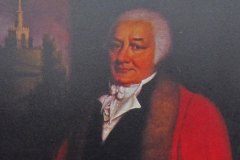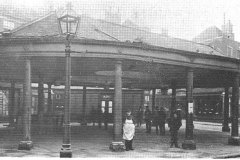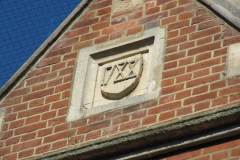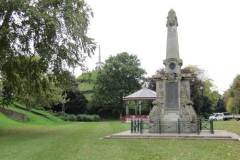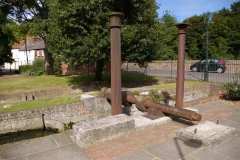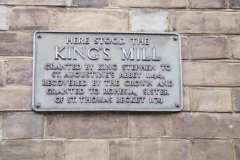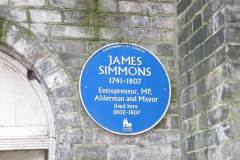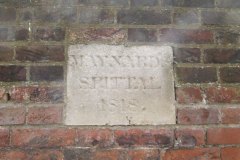Businessman, Alderman, Mayor, MP, JP, Publisher, Banker, Benefactor & Land Developer
James Simmons (Image 1) was born in Canterbury on 21 January 1741, son of William Simmons a barber and wigmaker. He attended King’s School from 1750 to 1756, and then served an apprenticeship in London as a stationer. He became a freeman of Canterbury in 1767, and during the next 40 years made an amazing personal contribution to the civic and commercial life of the city:
- He launched his own newspaper, the Kentish Gazette, in 1768.
- He also flourished as a publisher and printer, and was responsible for publication of the first edition of Hasted’s History and Topographical Survey of the County of Kent (1778-1798), Hasted’s City of Canterbury (1798), and several editions of Gostling’s A walk in and about the City of Canterbury (1774-1804).
- James was also active in city politics, elected alderman in 1774 for Riding Gate Ward. As treasurer to the newly formed Canterbury Pavement Commissioners (1787-1791) he played a central role in modernising the city’s streets. He served as mayor in 1776 and again in 1778.
- He was involved in the financing and construction of a new market place outside the Christchurch gates in 1790 – destined to become the Buttermarket (Image 2).
- James also played a key role in the city’s banks. Appointed Distributor of Stamps for East Kent in 1782, he went on to found the successful Canterbury Bank with Henry Gipp in 1788. This was taken over by Capital and Counties Bank in 1903, and became part of Lloyds Bank in 1918 – today there is still a Lloyds branch on the site of Simmons’ original bank (Image 3).
- Perhaps his prime contribution to the life of the city was his conversion of Dane John Field from a waste ground to a city park and garden (Image 4). Work started in 1790, and included the creation of a gravelled promenade with two rows of lime trees, planted shrubs, and landscaping of the Dane John mound to support a new monument (1803) visible from far around.
- Another change to the city skyline came in 1792 when Simmons, with his business partner Joseph Royal, engaged John Smeaton (of lighthouse fame) to design a new water mill to replace the Abbot’s Mill near Radigund bridge (Image 5). Over 100 feet high and costing £8,000 this incorporated major advances in the use of metal rather than timber for the main mill components. Simmons and Royal also rented Kings Mill at Eastbridge (Image 6), primarily to ensure an unobstructed water feed to the new Abbot’s Mill. The Kings Mill site was rebuilt as a home for Simmons a few years later (1803) – this is where his blue plaque now appears (Image 7).
- Amongst his last projects was the creation in 1803 of New Street (now Guildhall Street) aimed at relieving the impossible traffic bottleneck along Mercery Lane and Sun Street.
- For the final decade of his life, Simmons was elected each year to the honorary post of Master of Maynard’s almshouse (Image 8). In this role he overhauled and modernised the running of the organisation.
- In St Mildred’s cemetery we can see Simmons’ tomb (Image 9) and notice board (Image 10)
James stood as MP for Canterbury in 1806 and was returned unopposed. His tenure was, however very short. A large brain abscess started discharging through his left ear, and he died in early 1807. The main beneficiary to James’ will was his son, another James. Sources disagree on whether this was a legitimate son or not. Either way, the current day value of his £30,000 inheritance is little short of a million pounds, none of which seems to have benefited the city or people of Canterbury in any way.
Sources: Cantacuzino (1970); Panton (1990); articles by Marjorie Lyle appearing in the Kentish Gazette in January 2007

